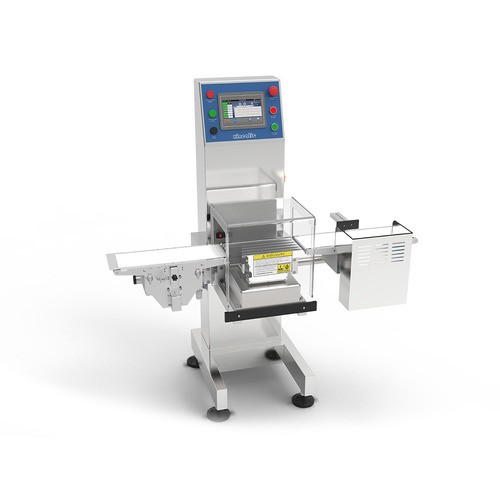Bakery Food
Design tunnel 400mm width height 120mm with belt conveyor 1350mm with speed 25meter/minute used in bread cheese and related food processing industry
Implementing an automatic conveyor system metal detector in bakery food production is crucial for ensuring product safety, quality, and compliance with industry standards. Detecting and removing metal contaminants from bakery items is a fundamental step in the food processing industry. Let's explore the significance, benefits, and key considerations associated with using an automatic conveyor system metal detector in the bakery food production process:
## I. Importance of Automatic Conveyor System Metal Detector in Bakery Food Production
### A. Food Safety
1. **Contaminant Prevention:** Metal detectors help prevent metal contaminants, such as metal fragments from processing equipment or foreign objects, from entering bakery items during the production process.
2. **Consumer Protection:** Ensuring that the final bakery products are safe for consumption and free from potential hazards associated with metal contamination.
### B. Quality Assurance
1. **Maintaining Product Integrity:** Metal detection contributes to the overall quality of bakery products by maintaining the integrity of ingredients and preventing undesirable elements.
2. **Compliance with Standards:** Meeting industry and regulatory standards for food safety and quality control.
## II. Key Stages for Automatic Conveyor System Metal Detection in Bakery Food Production
### A. Dough Mixing and Preparation
1. **Inline Inspection:** Metal detectors integrated into the conveyor system inspect dough and ingredients for any metal particles introduced during the mixing and preparation stages.
2. **Quick Rejection Systems:** Fast-acting rejection systems ensure that contaminated dough is immediately removed from the production line.
### B. Baking
1. **Continuous Monitoring:** Metal detectors along the baking conveyor system continuously monitor baked goods for any metal contamination introduced during the baking process.
2. **Quick Rejection Systems:** Rapid rejection systems ensure that contaminated products are swiftly removed from the production line.
### C. Packaging
1. **Final Inspection:** Metal detection at the end of the conveyor line ensures that metal contaminants are not present in the finished bakery products before packaging.
2. **Packaging Inspection:** Ensuring that metal contaminants are not introduced during the packaging process.
## III. Benefits of Automatic Conveyor System Metal Detector in Bakery Food Production
### A. Consumer Safety
1. **Preventing Injuries:** Eliminating the risk of consumers encountering metal contaminants in bakery products, which could lead to injuries or discomfort.
2. **Ensuring Edible Quality:** Enhancing the overall safety and edibility of bakery items by removing potential hazards.
### B. Operational Efficiency
1. **Reduced Downtime:** Early detection of metal contaminants helps prevent equipment damage, reducing downtime and minimizing disruptions in the production process.
2. **Enhanced Production Speed:** Ensuring a smooth production process by quickly identifying and eliminating metal contaminants without compromising production speed.
### C. Compliance and Reputation
1. **Regulatory Compliance:** Meeting food safety regulations and industry standards, ensuring continued market access, and compliance with quality control guidelines.
2. **Maintaining Brand Reputation:** Upholding the reputation of the bakery brand by delivering safe and high-quality products to consumers.
## IV. Implementing an Effective Automatic Conveyor System Metal Detection System
### A. Choosing Appropriate Equipment
1. **Type of Metal Detector:** Selecting the right type of conveyor-based metal detector based on the specific needs of the bakery food production process, considering factors such as belt width and sensitivity levels.
2. **Integration with Conveyors:** Ensuring seamless integration with conveyor systems for efficient and continuous inspection.
### B. Sensitivity Levels and Product Effect Compensation
1. **Adjustable Sensitivity:** Configuring the sensitivity levels of the metal detector to detect both ferrous and non-ferrous metals at the required thresholds.
2. **Product Effect Compensation:** Implementing features to compensate for the product's characteristics, such as moisture content or temperature, to avoid false detections.
### C. Rejection Systems
1. **Fast-Acting Rejection:** Employing rejection systems that act quickly to remove contaminated products from the conveyor line without disrupting the production flow.
### D. Regular Maintenance and Calibration
1. **Routine Checks:** Conducting routine checks, maintenance, and calibration of the automatic conveyor system metal detector to ensure optimal performance.
2. **Employee Training:** Training personnel on the proper use and maintenance of metal detection systems to maximize effectiveness.
## V. Conclusion
An automatic conveyor system metal detector is a crucial component in bakery food production, contributing to the safety, quality, and compliance of the final products. By implementing robust metal detection systems at various stages of the production process, bakeries can minimize the risk of metal contamination and deliver high-quality, safe, and consumer-friendly bakery items. Regular maintenance, proper training, and the selection of suitable metal detection equipment are key factors in achieving a successful and effective metal detection program in bakery food production.




